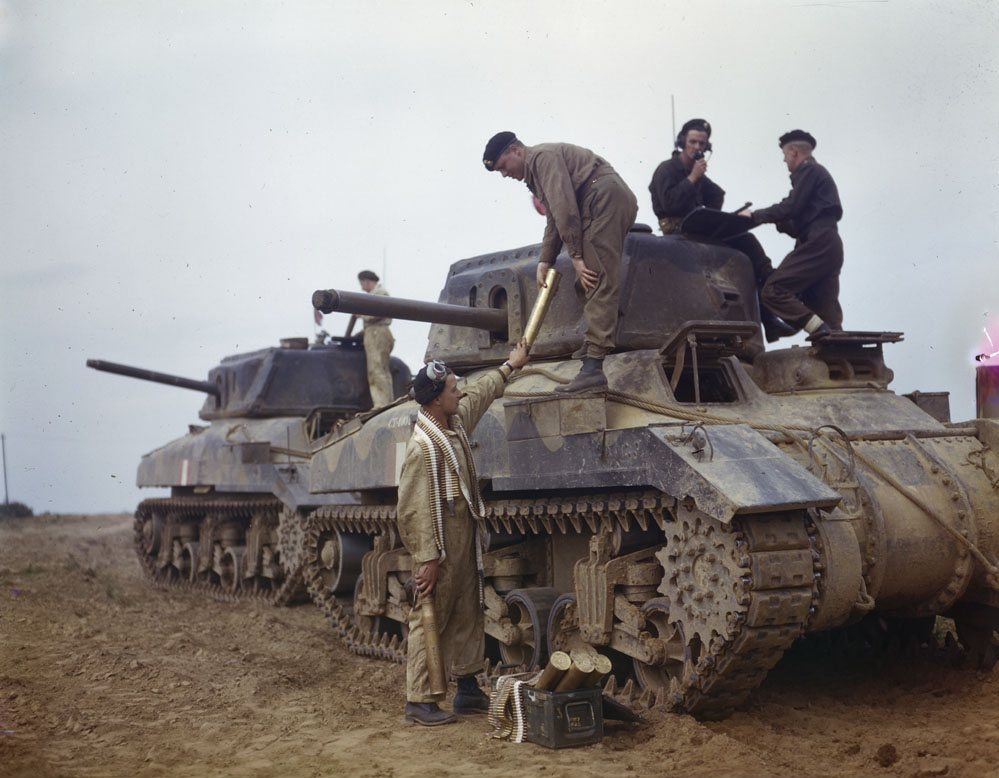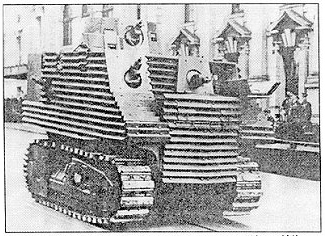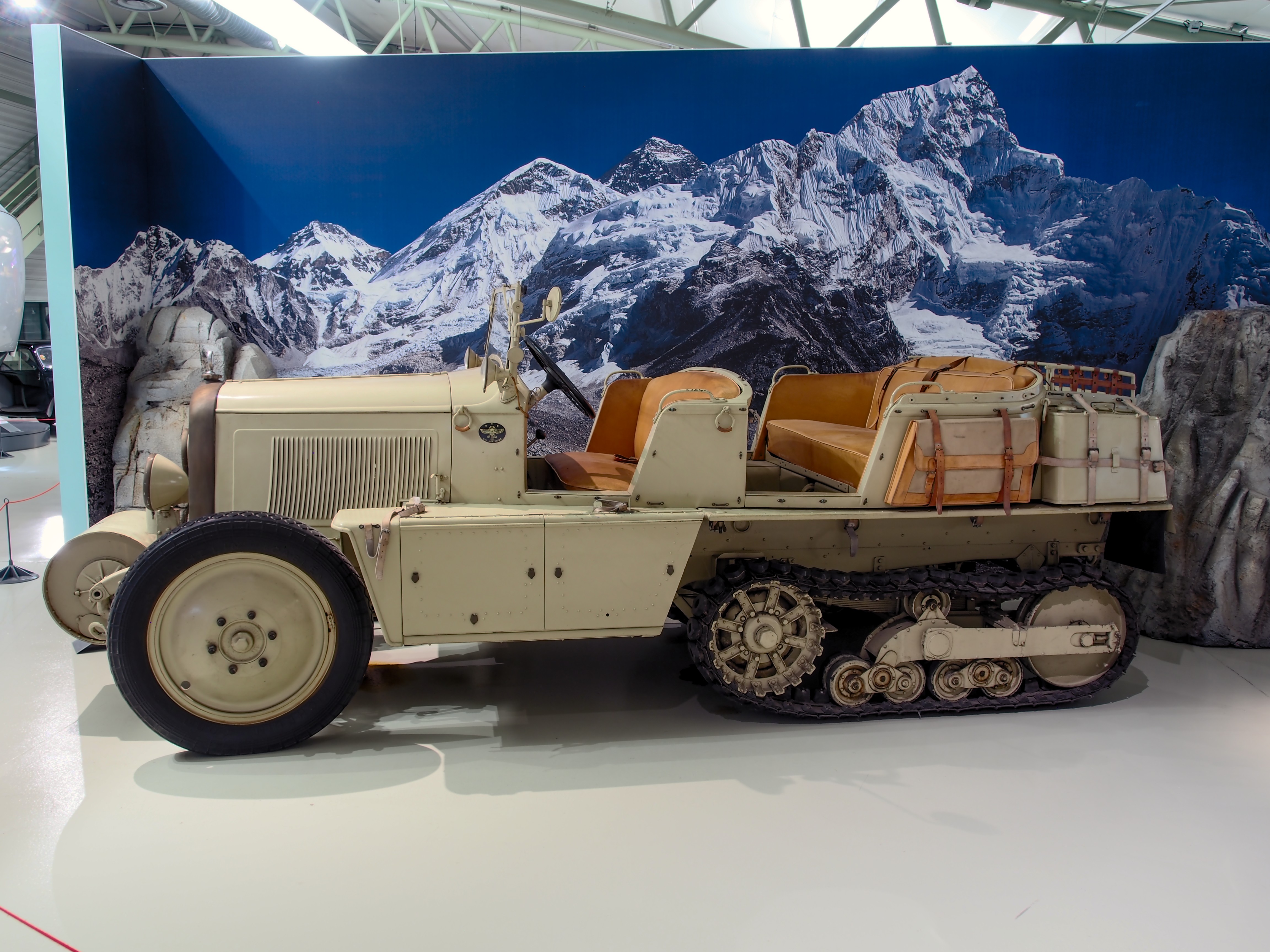|
Schofield Tank
The Schofield tank, named after its designer, was a New Zealand tank design of the Second World War. Developed in 1940 when it seemed that the Pacific War might reach New Zealand and with little likelihood of weapons coming from Britain, it did not enter service. It was designed to run on either tracks or wheels. Design and development When a need for the production of indigenous armoured fighting vehicles arose in 1940, E. J. Schofield, a motor vehicle dealer for General Motors in Wellington, approached the government with his own design. Schofield's tank was based on the chassis of a Chevrolet truck using the suspension from a Universal Carrier. Wheels normally carried on the hull could be bolted on so that it could use these rather than the tracks. As initially designed it had a crew of three: machine gunner and driver at the front and a second machine gun in a turret at the rear. The initial design performed badly in trials but the Government sought an improved version. ... [...More Info...] [...Related Items...] OR: [Wikipedia] [Google] [Baidu] |
New Zealand
New Zealand ( mi, Aotearoa ) is an island country in the southwestern Pacific Ocean. It consists of two main landmasses—the North Island () and the South Island ()—and over 700 smaller islands. It is the sixth-largest island country by area, covering . New Zealand is about east of Australia across the Tasman Sea and south of the islands of New Caledonia, Fiji, and Tonga. The country's varied topography and sharp mountain peaks, including the Southern Alps, owe much to tectonic uplift and volcanic eruptions. New Zealand's capital city is Wellington, and its most populous city is Auckland. The islands of New Zealand were the last large habitable land to be settled by humans. Between about 1280 and 1350, Polynesians began to settle in the islands and then developed a distinctive Māori culture. In 1642, the Dutch explorer Abel Tasman became the first European to sight and record New Zealand. In 1840, representatives of the United Kingdom and Māori chiefs ... [...More Info...] [...Related Items...] OR: [Wikipedia] [Google] [Baidu] |
New Zealand Railways Department
The New Zealand Railways Department, NZR or NZGR (New Zealand Government Railways) and often known as the "Railways", was a government department charged with owning and maintaining New Zealand's railway infrastructure and operating the railway system. The Department was created in 1880 and was corporatised on 1 April 1982 into the New Zealand Railways Corporation. Originally, railway construction and operation took place under the auspices of the former provincial governments and some private railways, before all of the provincial operations came under the central Public Works Department. The role of operating the rail network was subsequently separated from that of the network's construction. From 1895 to 1993 there was a responsible Minister, the Minister of Railways. He was often also the Minister of Public Works. Apart from four brief experiments with independent boards, NZR remained under direct ministerial control for most of its history. History Originally, New Zea ... [...More Info...] [...Related Items...] OR: [Wikipedia] [Google] [Baidu] |
World War II Tanks Of New Zealand
In its most general sense, the term "world" refers to the totality of entities, to the whole of reality or to everything that is. The nature of the world has been conceptualized differently in different fields. Some conceptions see the world as unique while others talk of a "plurality of worlds". Some treat the world as one simple object while others analyze the world as a complex made up of many parts. In ''scientific cosmology'' the world or universe is commonly defined as " e totality of all space and time; all that is, has been, and will be". '' Theories of modality'', on the other hand, talk of possible worlds as complete and consistent ways how things could have been. '' Phenomenology'', starting from the horizon of co-given objects present in the periphery of every experience, defines the world as the biggest horizon or the "horizon of all horizons". In ''philosophy of mind'', the world is commonly contrasted with the mind as that which is represented by the mind. ''T ... [...More Info...] [...Related Items...] OR: [Wikipedia] [Google] [Baidu] |
Tanks Of New Zealand
The New Zealand Army use of tanks from after the First World War, through the interwar period, the Second World War, the Cold War and to the present day has been limited, but there is some history. The New Zealand armed forces developed in the early twentieth century but served alongside the British and other Empire and Commonwealth nations in World War I and World War II. The outbreak of the Second World War in 1939 led to an expansion of New Zealand's armoured force and the New Zealand Armoured Corps was formed in January 1942. From 1942 small numbers of American light and medium tanks were supplied to and used by the New Zealand Army, along with British tanks. Throughout this period the Army has primarily been a light infantry force, but New Zealand did design its own tanks such as the Schofield tank named after its designer, and the Bob Semple tank designed by New Zealand Minister of Works (New Zealand), Minister of Works Bob Semple during World War II. Overview Originati ... [...More Info...] [...Related Items...] OR: [Wikipedia] [Google] [Baidu] |
Grizzly Tank
The Grizzly I was a Canadian-built M4A1 Sherman tank with relatively minor modifications, primarily to stowage and pioneer tool location and adding accommodations for a number 19 radio set. They used the same General Steel hull castings as late Pressed Steel M4A1(75)s, to include both, the standard hull and the later ones with the armour thickened over the ammo bins. Grizzlies were originally built with US style tracks and sprockets. It was only later that they were refitted with Canadian Dry Pin tracks (CDP) tracks, which did not require rubber. The tank's production was stopped as it became apparent US production would be sufficient for the Allies' needs and the factory was turned over to other production. After the war, a number of Grizzly tanks were sold to Portugal as part of the NATO military assistance program; they were retired in the 1980s. History After the fall of France, it was decided the nascent Canadian armoured divisions would be equipped by tanks produced in ... [...More Info...] [...Related Items...] OR: [Wikipedia] [Google] [Baidu] |
Ram Tank
The Tank, Cruiser, Ram was a cruiser tank designed and built by Canada in the Second World War, based on the U.S. M3 Medium tank chassis. Due to standardization on the American Sherman tank for frontline units, it was used exclusively for training purposes and was never used in combat as a gun tank. The chassis was used for several other combat roles however, such as a flamethrower tank, observation post, and armoured personnel carrier. Development Even before the loss of the majority of the United Kingdom's tank force in France in 1940 after Dunkirk, it was recognised that tank production in the UK at the start of the war was insufficient and capacity in the US was taken for British needs.Ellis and Chamberlain p3 So it was necessary that if Canada was to equip with tanks they would have to be manufactured locally.Ellis and Chamberlain In June 1940 the Canadian Pacific Railway's Angus Shops in Montreal, as the only large firm with spare capacity, had received a contract to ... [...More Info...] [...Related Items...] OR: [Wikipedia] [Google] [Baidu] |
Sentinel Tank
The AC1 Sentinel was a cruiser tank designed in Australia in World War II in response to the war in Europe, and to the threat of Japan expanding the war to the Pacific or even a feared Japanese invasion of Australia. It was the first tank to be built with a hull cast as a single piece, and the only tank to be produced in quantity in Australia. The few Sentinels that were built never saw action as Australia's armoured divisions had been equipped by that time with British and American tanks. History When design work began in November 1940, the AC1 was originally intended to be a 2 pounder gun-equipped vehicle, a true Cruiser tank, with a weight of between 16 and 20 tonnes. Due to a lack of home grown experience in tank design, a mission was sent to the US to examine the M3 design and Colonel W.D. Watson MC, an artillery officer with many years of tank design experience was provided by the UK. He arrived in December 1940. Like the Canadian Ram, the Australian Cruiser was to be ba ... [...More Info...] [...Related Items...] OR: [Wikipedia] [Google] [Baidu] |
Bob Semple Tank
The Bob Semple tank (sometimes referred to as Big Bob) was a light tank designed by New Zealand Minister of Works Bob Semple during World War II. Originating out of the need to build military hardware from available materials, the tank was built from corrugated iron on a tractor base. Designed and built during a period of uncertainty in which New Zealand feared having to defend itself from Japanese invasion without external assistance, these tanks were a civilian effort to design and create a means to protect New Zealand. Designed and built without formal plans or blueprints, it had numerous design flaws and practical difficulties, and was never put into mass production or used in combat. Design and construction At the onset of the Second World War, New Zealand - like its neighbour Australia - had no indigenous armoured fighting vehicle industry, and it was expected that armoured fighting vehicles would be imported from Britain. Although Australiasee Sentinel tank and New Zea ... [...More Info...] [...Related Items...] OR: [Wikipedia] [Google] [Baidu] |
Half-track
A half-track is a civilian or military vehicle with regular wheels at the front for steering and continuous tracks at the back to propel the vehicle and carry most of the load. The purpose of this combination is to produce a vehicle with the cross-country capabilities of a tank and the handling of a wheeled vehicle. Performance The main advantage of half-tracks over wheeled vehicles is that the tracks reduce the pressure on any given area of the ground by spreading the vehicle's weight over a larger area, which gives it greater mobility over soft terrain like mud and snow, while they do not require the complex steering mechanisms of fully tracked vehicles, relying instead on their front wheels to direct the vehicle, augmented in some cases by track braking controlled by the steering wheel. It is not difficult for someone who can drive a car to drive a half-track, which is a great advantage over fully tracked vehicles, which require specialized training. Half-tracks thus facil ... [...More Info...] [...Related Items...] OR: [Wikipedia] [Google] [Baidu] |
Department Of Tank Design
Department may refer to: * Departmentalization, division of a larger organization into parts with specific responsibility Government and military *Department (administrative division), a geographical and administrative division within a country, for example: **Departments of Colombia, a grouping of municipalities **Departments of France, administrative divisions three levels below the national government **Departments of Honduras **Departments of Peru, name given to the subdivisions of Peru until 2002 **Departments of Uruguay *Department (United States Army), corps areas of the U.S. Army prior to World War I *Fire department, a public or private organization that provides emergency firefighting and rescue services *Ministry (government department), a specialized division of a government *Police department, a body empowered by the state to enforce the law * Department (naval) administrative/functional sub-unit of a ship's company. Other uses * ''Department'' (film), a 2012 Bollywoo ... [...More Info...] [...Related Items...] OR: [Wikipedia] [Google] [Baidu] |
Ordnance QF 2-pounder
The Ordnance QF 2-pounder ( QF denoting "quick firing"), or simply "2 pounder gun", was a British anti-tank gun and vehicle-mounted gun employed in the Second World War. It was the main anti-tank weapon of the artillery units in the Battle of France and, due to the need to rearm quickly after the Dunkirk evacuation, remained in service during the North African campaign. In its vehicle-mounted variant the 2-pounder was a common main gun on British tanks early in World War II, as well as being a typical main armament of armoured cars, such as the Daimler, throughout the war. As the armour protection of Axis tanks improved, the 2-pounder lost effectiveness and it was gradually replaced by the 57 mm QF 6-pounder starting in 1942. It equipped infantry battalion anti-tank platoons replacing their anti-tank rifles until in turn replaced by 6-pounders but remained in service until the end of the war. This QF 2-pounder was distinctly different from the QF 2 pounder "pom-pom" gun ... [...More Info...] [...Related Items...] OR: [Wikipedia] [Google] [Baidu] |
Horstmann Suspension
Horstmann suspension, also known as Horstman, Vickers-Horstman and rarely Slow Motion, is a type of tracked suspension devised by British tank designer John Carden and worked into a production design by engineer Sidney Horstmann. First used on the A6E3 Medium Tank prototype in 1935, it proved far superior to previous suspensions from Vickers. It was widely used on World War II-era tank designs but in the post-war era was increasingly limited to British tanks as newer systems emerged in other countries. The last tank to use this basic mechanism was the Chieftain, designed in the late 1950s. Horstman Defence Systems remains a tank suspension specialist to this day. They make a range of systems based mostly on torsion systems with hydrodynamic damping. These are also referred to as "Horstman suspensions" although they have no details in common with their earlier designs. History Sidney Horstmann became interested in suspension designs in the 1920s as part of his efforts to imp ... [...More Info...] [...Related Items...] OR: [Wikipedia] [Google] [Baidu] |








